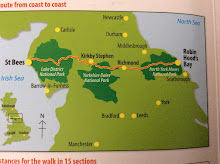Hospitaleras, Heather and Hydrangeas, Hamlets and Horreós
Galicia is different. It is green and rocky; it is incised valleys and upland meadows; it is historical and hospitable; it is fishing ports and sandy beaches; it is the end of all 'caminos' as it holds the shrine of Saint James. With its oaks and chestnuts, muddy lanes and windswept moorland, trickling streams and flowing rivers, lush gardens and barren hillsides Galicia presents many faces to the traveller, and to the weary and footsore they are all refreshing faces. Among these it is the 'Hospitaleras', the heather and hydrangeas, the hamlets and the 'horreós' that stand out most clearly.
The 'albergues' of the ´Camino Sanabrese' were clean and modern. Some were glass walled, several had complex electronic lighting systems and one had an almost unfathomable automatic electric cooker. Often they were popular and full as they lay at the end of recognised stages, but always there was a 'hospitalera' ready to record details. Then for a princely 5 euros she would issue a disposable sheet and pillowcase that ensured the modern mattresses were respected and of course clean. These were cheerful ladies happy to contribute advice and local directions but determined also to fulfil a sometimes thankless task when late arrivals became extra demanding. They are certainly a significant part of the 'camino' in Galicia.
Between the mountain pass of 'A Canda' and the wooden crosses above Portocambo and on Monte Talariño, crosses set up to mark the route travelled by Galician reapers on their way to work the cornfields of Castille, wild flowers made way for heather. Here were puddles of pinkish purple where exposed rocks left little shelter, taller stems of deeper purple where conditions supported growth and finally straggly stands of blown flowers where better soil had favoured early blossoms, now bleached and dried by sun and wind. In all they offered colour enough to ease even the harsher moments and brighten the long ridge walk betweeen the 'Ventas' of the 'Sierra Seca' that marks the route between A Gudiña and Campocerros de Santiago. When further on the 'camino' moved into lower ground, wild hydrangeas appeared. First they were white, then blue and finally nearer the coast more luxuriant purples and pinks arrived. Their bright banks of colour decorated walls and paths and then reappeared in gardens. Where spindly heather had battled to survive and in doing so had offered a background 'colour wash', these leafy hydrangeas simply stole the scene by splashing their colours freely to create another face of Galicia.
If the 'Ventas' of the 'Sierra Seca' were now abandoned by all by the most hardy of their elderly residents, the villages and hamlets in other parts still add life and colour to the 'camino'. These are places largely untouched by modern road building and where the concrete main street still threads its narrow way between what were once finely dressed stone walls, outside stone steps and timber balconies, all now reflecting the crumbling dated elegance of former years. But they are still places to sit and watch the residents at work, at home, in the street or in their nearby vegetable patch; here the cows and sheep still amble past, for the street is the focus of village life. These are then communities built close together for shelter from both heat and chill, where stone and tile reflect techniques now disappearing as technology and convenience demand more modern solutions. But here at least the traditions of of the countryside can still be seen and this most obviously in the preference for 'horreós' to store the winter maize.These are tiled, stone framed sheds set up on overhanging stone feet to deny access to foraging rats and mice. Decked appropriately with a cross at one end of the roof, some had slatted wooden sides, others gapped stone sides; some were short, some longer, some single tiered and a few double storied. They come as singles, in pairs and occasionally in clusters of three or more. Like the 'Hospitaleras', the heather and hydrangeas, and the hamlets, the 'horreós' belong to Galicia and remain a splendid icon of rural life.

No comments:
Post a Comment